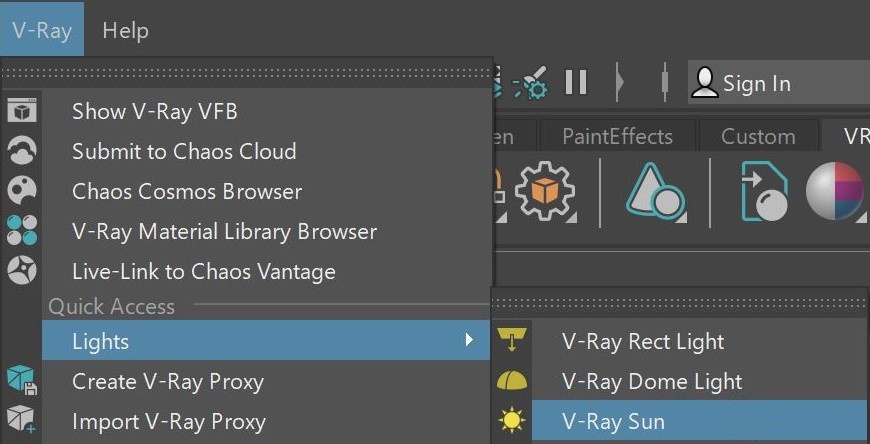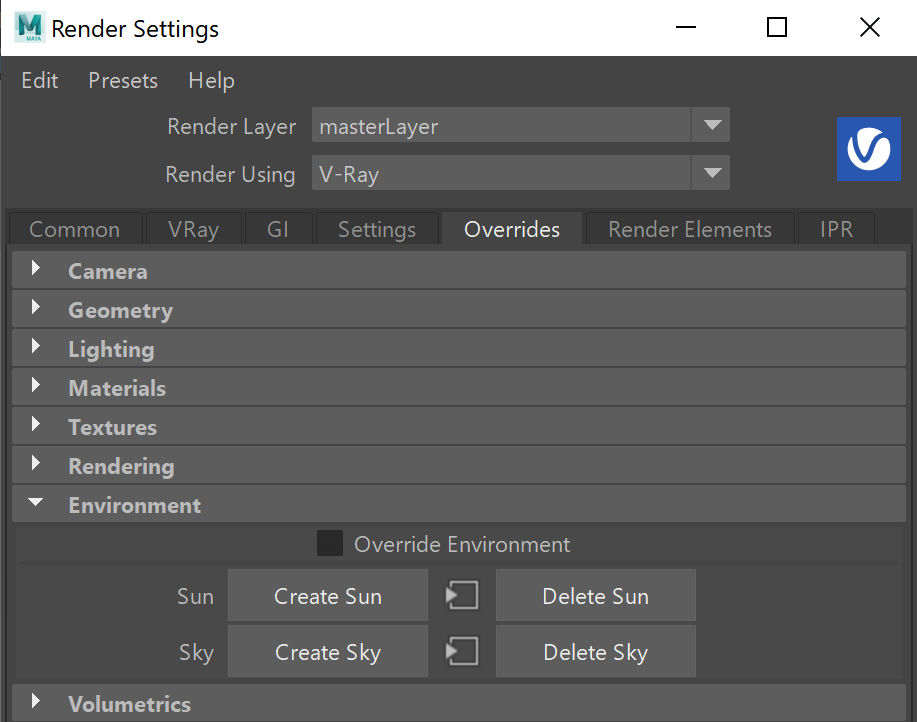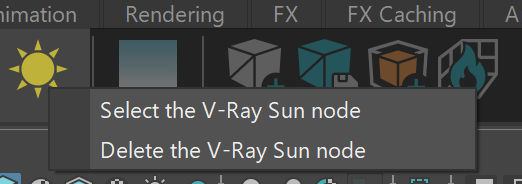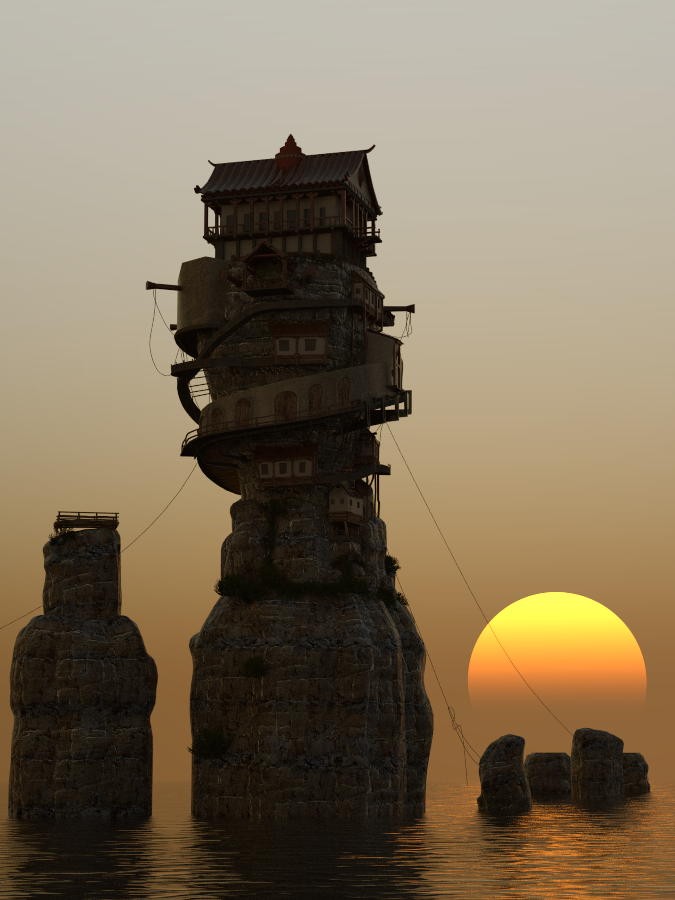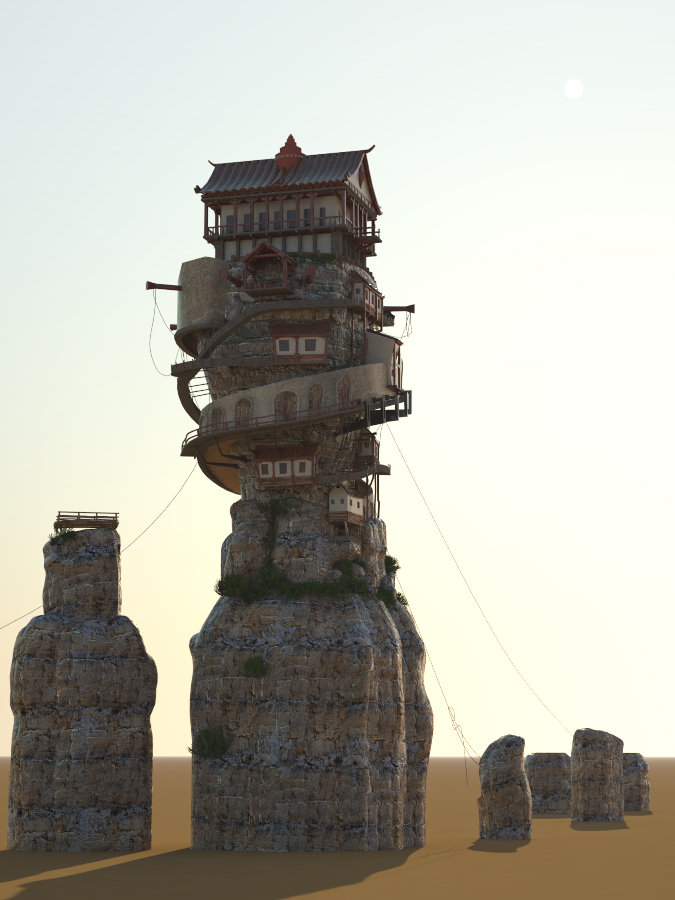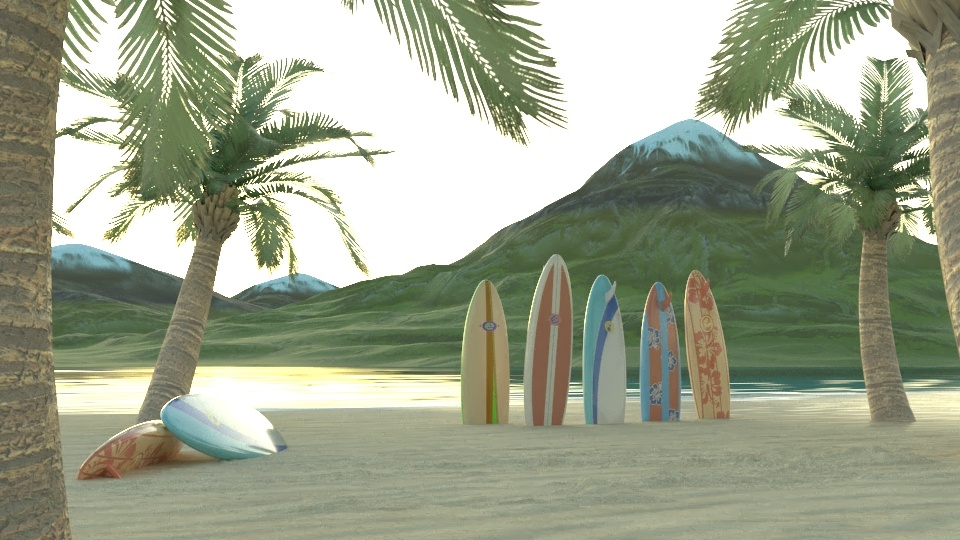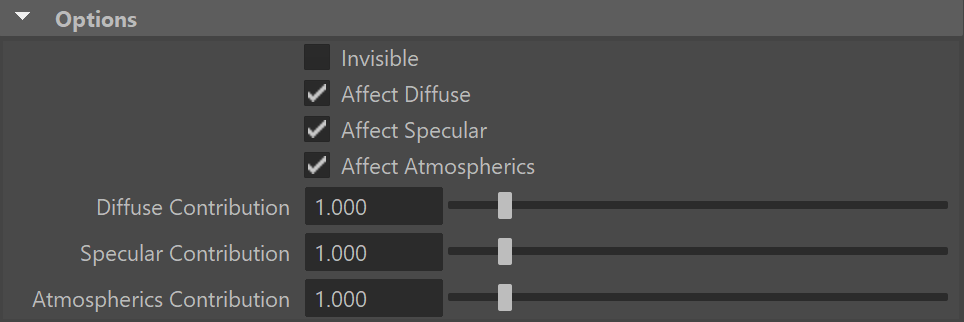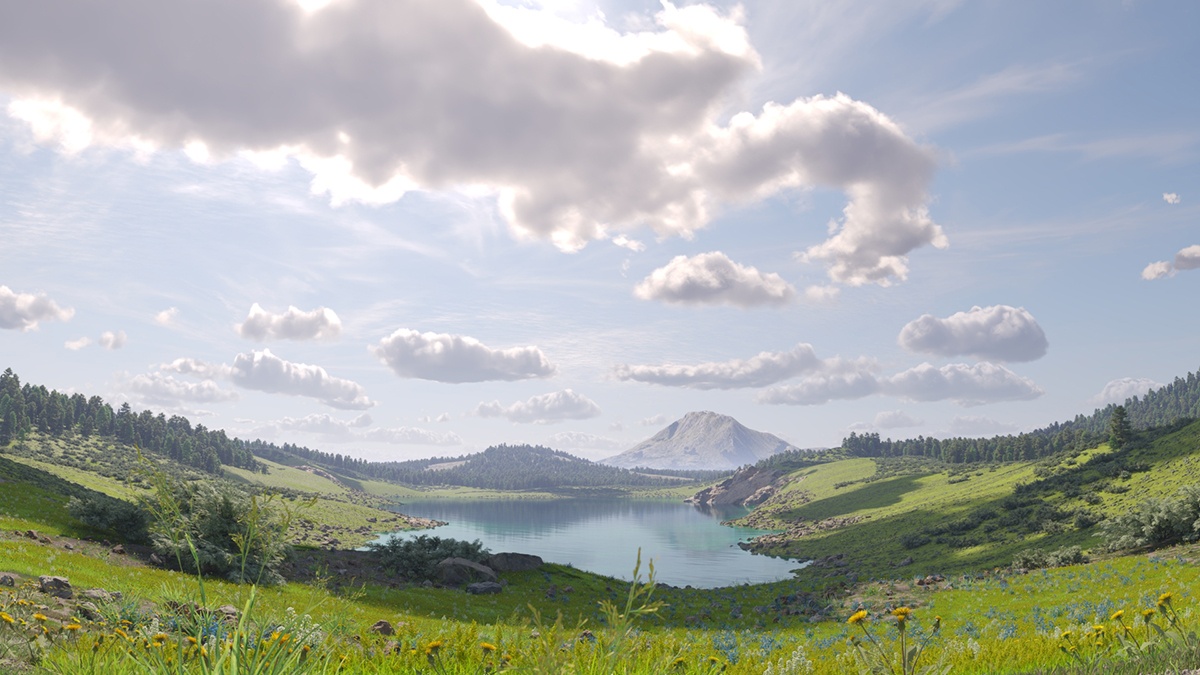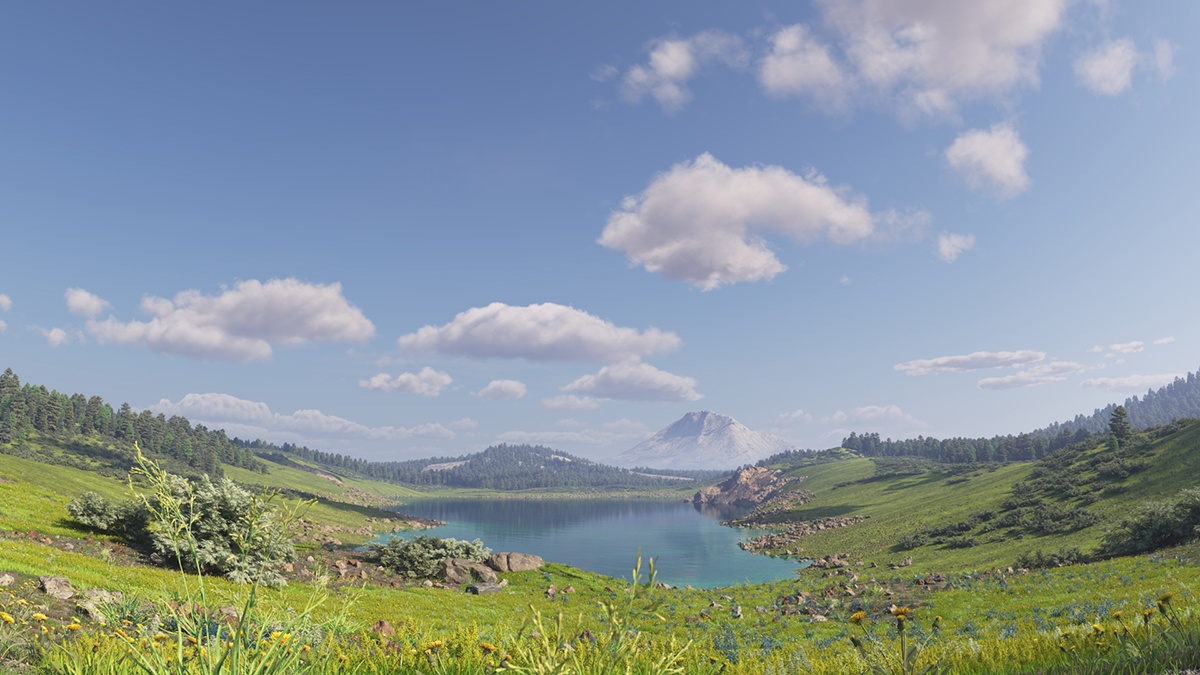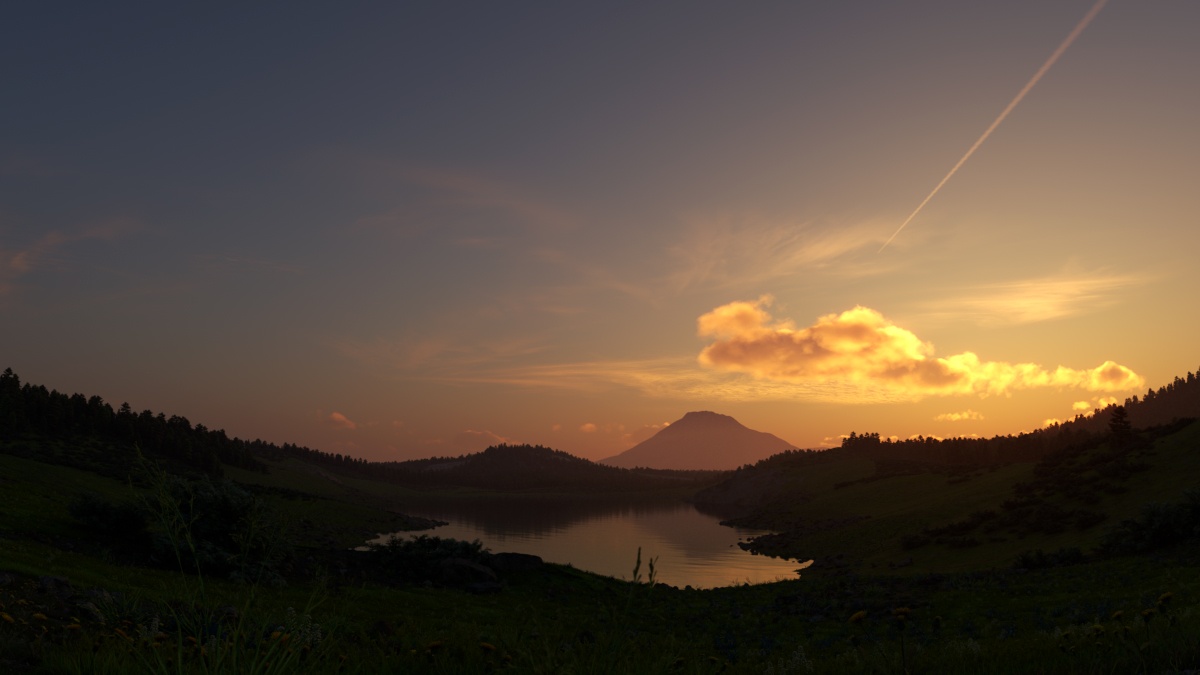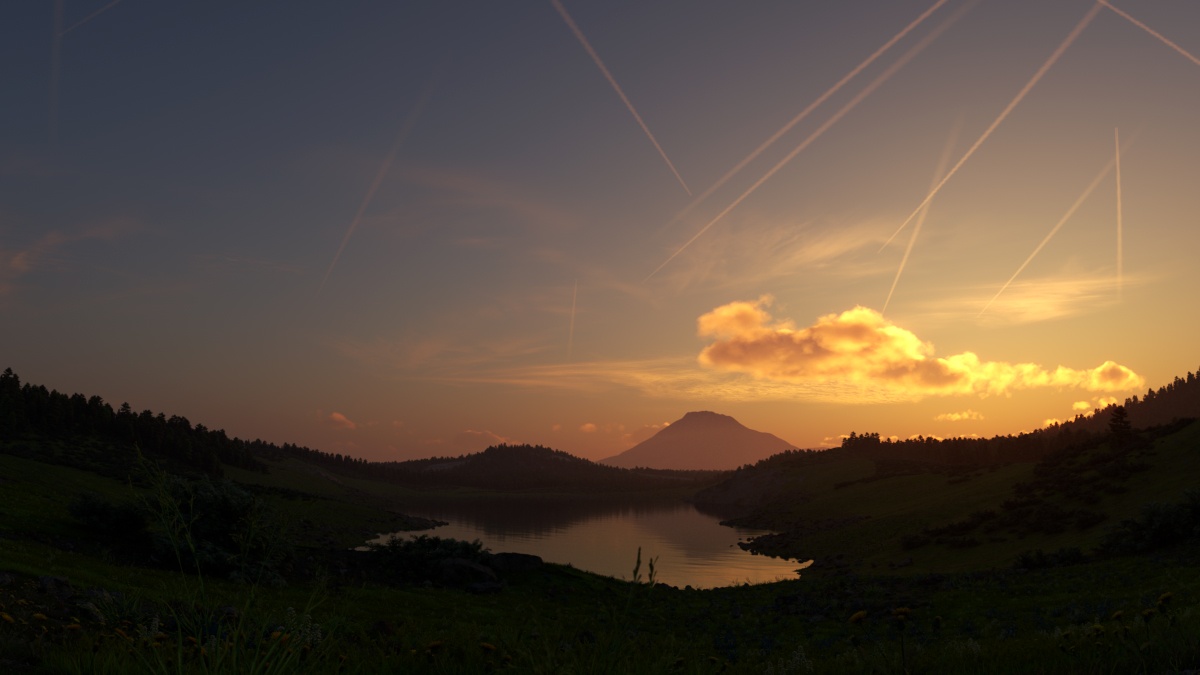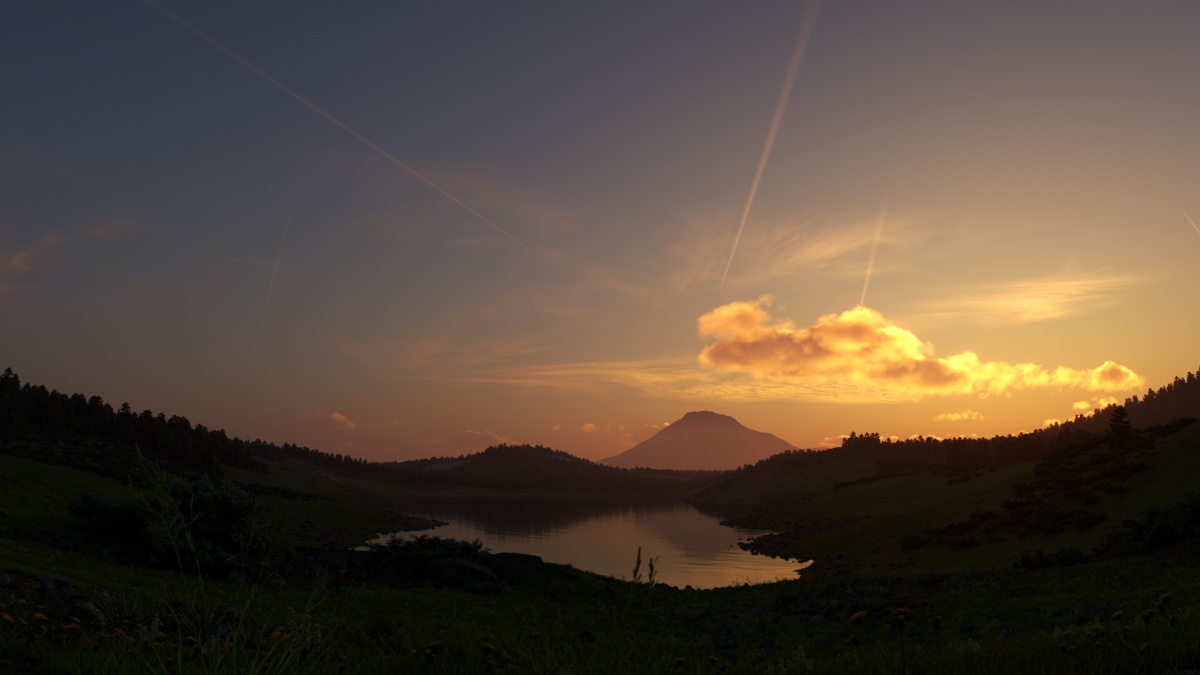This page gives details on how the physical sun and sky system works in V-Ray.
Overview
The VRaySun and VRaySky are special features which are provided by the V-Ray renderer. Developed to work together, the VRaySun and VRaySky reproduce the real-life sun and sky environment of the Earth. Both are coded so that they change their appearance depending on the direction of the VRaySun.
The VRayGeoSun node allows you to set the position of the V-Ray Sun for a specific place in the world at a given time.
The VRaySun is frequently used with the environment texture map VRaySky.
The V-Ray Sun and Sky systems are based largely on the SIGGRAPH 1999 paper A Practical Analytic Model for Daylight [1]. For a complete list of references, please see the References section.
Note that for the Clouds to work with VRaySun, a VRaySky is required.
Image © Colorbleed
Parameters
After the sun is created, its parameters appear in the Attribute Editor.
Enabled – Turns the sun light on and off.
Intensity multiplier – The brightness of the sun. Since the sun is very bright by default, you can use this parameter to reduce its effect. See the Notes section for more information. For more information, see the Intensity Multiplier example below.
Turbidity – Determines the amount of dust in the air, which in turn affects the color of the sun and sky. Smaller values produce a clear, blue sky and sun similar to what is seen in rural areas, while larger values make the sun and sky more yellow and orange as seen in a big city. For more information, see the Turbidity example below. The minimum value possible is 1.81 and the maximum value is 4.89.
Ozone – Affects the color of the sun light. Available in the range between 0.0 and 1.0. Smaller values make the sunlight more yellow, while larger values make it bluer. For more information, see the Ozone example below.
Size multiplier – Controls the visible size of the sun. This affects the appearance of the sun disc as seen by the camera and reflections, as well as the blurriness of the sun shadows. For more information, see the Size Multiplier example below.
Sky Model – Determines the procedural model used to generate the VRaySky texture. See the Sky model example below for more information.
Hosek et al. – The VRaySky procedural texture is generated based on the Hosek et al. method.
Preetham et al. – The VRaySky procedural texture is generated based on the Preetham et al. method.
CIE Clear – The VRaySky procedural texture is generated based on the CIE method for a clear sky.
CIE Overcast – The VRaySky procedural texture is generated based on the CIE method for a cloudy sky.
PRG Clear Sky – The V-Ray Sky procedural texture is generated using the PRG Clear Sky method. The updated PRG Clear Sky allows for rendering the sky at various observer altitudes, up to several kilometers. It also supports rendering of nautical twilight effects with sun positions up to 12 degrees below the horizon. Additionally, it features enhanced turbidity control, enabling the rendering of sky conditions with turbidity values ranging from 1.81 to 4.89. See the PRG Clear Sky examples below.
The PRG Clear Sky model in scenes created with V-Ray 7 cannot be rendered using previous V-Ray versions.
Horiz Illumination – Specifies the intensity (in lx) of the illumination on horizontal surfaces coming from the sky. This parameter is enabled when one of the CIE Sky Models are selected.
Color Mode – This mode affects the way the Filter Color hues the sun and sky light.
Filter – Shifts the V-Ray Sun and Sky hue towards the color specified by the Filter Color.
Direct – Takes the Filter Color for the V-Ray Sun light. In this case, the light intensity is controlled by the Intensity multiplier and it does not depend on the Sun's position in the sky.
Override – Takes the Filter Color for the V-Ray Sun light, however the intensity is controlled by the position of the V-Ray Sun in the sky.
Filter Color – Shifts the hue of the V-Ray Sun and Sky system towards the specified color.
Ground Albedo – Sets the color of the V-Ray Sun and Sky system's ground.
Blend Angle – Specifies the angle in degrees where blending will occur between the horizon line and sky. Values close to 0.0 produce a sharper horizon line, while larger values produce a softer horizon line.
Horizon Offset – Allows the user to manually lower the horizon line.
Altitude – Controls the observer's altitude in meters. As the altitude increases, sky clarity improves, and the horizon line becomes less defined.
Example: Intensity Multiplier
The Intensity Multiplier of the V-Ray Sun adjusts the brightness of it in the scene. This is also affected by the height of the Sun in the scene. To simulate the way the sun actually works, the closer the V-Ray Sun is on the horizon, the warmer the color and the less bright it will appear in the render. As you raise it up, the color will be cooler (or bluer) and the brighter it will be, like mid-day light. In the example renders below, the common settings are Turbidity: 3.3 and Size multiplier: 3.0 (which does not change the brightness), while the height (from the horizon) and Intensity Multiplier are adjusted.
Example: Turbidity and Sun Height
Turbidity creates the look of the light from the Sun having to travel through particles in the atmosphere, like smog (when the value is increased). This example shows how the Turbidity attribute is affected by the height of the V-Ray Sun in our scene. The common settings are Intensity multiplier: 1, Size multiplier: 3, while the height and Turbidity are adjusted.
Example: Ozone value
The Ozone attribute doesn't change the color of the sky, but the color of the light that hits the objects in the scene. It's a subtle effect but can help boost the photo-realism of your renders. In this example, the only thing that is adjusted is the Ozone value, while the height of the sun remains the same and the following attributes are constant; Turbidity: 2.0, Intensity multiplier: 1.0, Size multiplier: 3.0.
Example: Size multiplier (Size & Area shadows effect)
The Size multiplier has no effect on the brightness of the V-Ray Sun. As shown early, the Intensity multiplier is adjusted to change how bright the light is coming from the Sun. The Size multiplier does, however, change the visual representation of the Sun when it's seen in the render and just like with other (physically accurate) lights, the larger they are, the softer the shadows are that are cast from that light. Increasing this attribute as the height of the sun is lowered can also help in the realism of your renders. In the following example, the height of the Sun and the Size multiplier are adjusted, while values for attributes, such as Intensity multiplier (at 1.0), are constant. The first series of images show how the size of the sun is displayed in the reflection of the water. The second set shows the shadows being cask on a ground plane.
Example: Sky Model
This example shows the different Sky models. The sun's position is close to the horizon and all other parameters are at their defaults.
Example: PRG Clear Sky - Turbidity
In this example, you can see how the amount of dust in the air affects the color of the sun and sky. Smaller values produce a clear image, while higher values dim the sun and sky.
Example: PRG Clear Sky - Altitude
This example shows how the Altitude values affect the visualization of the sky. Higher Altitude values result in better sky clarity and a less defined horizon line.
Example: PRG Clear Sky - Nautical twilight effect
This example shows how the sun's position affects the sky, creating a twilight effect. Changing the sun's position could require adjusting the Exposure Value as well.
Shadows
Cast Shadows – When enabled, the sun produces shadows.
Cast Shadows from environment – When enabled, the sun produces shadows from volumetric effects.
Shadow bias – Moves the shadow toward or away from the shadow-casting object (or objects). Higher values move the shadow toward the object(s) while lower values move it away. If this value is too extreme, shadows can "leak" through places they shouldn't or "detach" from an object. Other effects from extreme values include Moire patterns, out-of-place dark areas on surfaces, and shadows not appearing at all in the rendering. For more information, see the Shadow Bias example below.
Shadow Color – Sets the color of the V-Ray Sun and Sky shadows. This option is inactive when using the V-Ray CUDA engine.
Example: Shadow Bias
In the example renders below, the common settings are Intensity multiplier: 1, Size multiplier: 3.0, while the Shadow bias is the only attribute adjusted between renders. The values shown in the example are highly exaggerated to help show the effect the Shadow bias has on the scene. The change in the shadow position is most noticeable on the front of the building below the roof line where the shadow cast by the roof recedes back toward the top left overhang of the roof as the Shadow bias value increases.
Options
Invisible – When enabled , makes the sun invisible, both to the camera and to reflections. This is useful to prevent bright speckles on glossy surfaces where a ray with low probability hits the extremely bright sun disk.
Affect Diffuse – Determines whether the VRaySun is affecting the diffuse properties of the materials.
Affect Specular – Determines whether the VRaySun is affecting the specular of the materials. The multiplier controls the suns contribution to specular reflections.
Affect Atmospherics – Determines whether the light influences the atmospheric effects in the scene.
Diffuse Contribution – A multiplier for the effect of the light on the diffuse. Smaller values result in less contribution over the diffuse channel, while larger values result in more intense light contribution. A value of 0 stops any VRaySun light contribution over the diffuse.
Specular Contribution – A multiplier for the effect of the light on the specular. Smaller values result in less contribution over the specular channel, while larger values result in more intense light contribution. A value of 0 stops any VRaySun light contribution over the specular.
Atmospherics Contribution – Determines the amount of influence the light has on the atmospheric effects such as VRayEnvironmentFog, VRayVolumeGrid or Phoenix effects. Smaller values result in less contribution over the atmospherics, while larger values result in more intense light contribution. A value of 0 stops any VRaySun light contribution over the atmospheric effects.
Photon Emission
Photon radius – Determines the radius of the area in which photons will be shot. This area is represented by the cylinder around the Sun's ray vector. This parameter has effect when photons are used in the GI solutions or caustics. See the Photon Emission Radius example for more information.
Caustics subdivs – Used by V-Ray when calculating Caustics. Lower values mean more noisy results but will render faster. Higher values produce smoother results but take more time. This option is inactive when using the V-Ray CUDA engine.
Caustics Multiplier – Used by V-Ray when calculating Caustics. This multiplier controls the brightness of the caustics. This option is inactive when using the V-Ray CUDA engine.
Clouds
Clouds On – Enables the cloud system.
Ground Shadows – When disabled, the entire scene is covered by a single shadow or fully illuminated depending on whether the sun is blocked by a cloud at the current camera position. This is useful for smaller scenes and speeds up the rendering process. When enabled, V-Ray calculates the shadows precisely at every point of the scene. This provides a lot more definition to the shadows but may slow down the rendering process. It is helpful in larger scenes where the effect of the clouds is more visible. See the Ground Shadows example below for more information.
Density – Controls the density of the cumulus and stratus types of clouds. A value of 1 fills up the sky with clouds. See the Density example below for more information.
Density Multiplier – A multiplier to the Density parameter. The larger the value, the darker the sky becomes at the horizon. Setting a value of 0 results in no clouds, regardless of the Density value.
Variety – Controls the variety of the cumulus and stratus types of clouds. See the Variety example below for more information.
Seed – Generates a random value, based on the given number, to change the pattern of the clouds and the contrails.
Cirrus Amount – The maximum value of 1 fills the sky with cirrus clouds. Decreasing the value, lowers the presence of such clouds. When set to 0, the cirrus clouds are completely gone. See the Cirrus Amount example below for more information.
Longitude Offset (m) – Moves the cloud system along the longitude. For more information, see the Longitude and Latitude Offset example below.
Latitude Offset (m) – Moves the cloud system along the latitude. For more information, see the Longitude and Latitude Offset example below.
Height (m) – Specifies the cloud position in height. For more information, see the Height example below.
Thickness (m) – Lower values make the cumulus and stratus types of clouds thin and sheer/lucent, while higher values make them full and heavy. For more information, see the Thickness example below.
Longitude Phase (%) – Controls the phase by longitude and it can be used to fine-tweak the cumulus and stratus clouds appearance. The appearance of the clouds loops at 0, 100, 200, etc. This parameter can be animated to resemble natural clouds appearance.
Latitude Phase (%) – Controls the phase by latitude and it can fine-tweak the cumulus and stratus clouds appearance. The appearance of the clouds loops at 0, 100, 200, etc. This parameter can be animated to resemble natural clouds appearance.
Enable Contrails – When enabled, plane contrails are simulated in the sky.
Number of Contrails – Determines the number of contrails generated. See the Number of Contrails example below for more information.
Contrails Strength – Determines the opacity of the contrails. Lower values create less opaque trails, which look older. See the Contrails Strength example below for more information.
Contrails Distortion – Determines the amount of distortion in the contrails. See the Contrails Distortion example below for more details.
Contrails Offset Long. (m) – Offsets the contrails by a given value, according to the X axis. See the Contrails Offset example below for more information.
Contrails Offset Lat. (m) – Offsets the contrails by a given value, according to the Y axis. See the Contrails Offset example below for more information.
Contrails Time – Determines how far the contrails progress along the sky. See the Contrails time animation below for more details.
Example: Ground Shadows
The following example shows the effect of the Ground Shadows option.
Example: Density
The Density parameter controls the amount of clouds in the sky. The higher the value, the higher the amount of clouds appearing in the render.
Example: Variety
This example shows how the Variety parameter affects the distribution and look of the clouds.
Example: Cirrus Amount
This example shows how increasing the Cirrus Amount increases the appearance of the cirrus clouds in the render.
Example: Longitude and Latitude Offset
This example shows how changing the Longitude and Latitude offsets affects the appearance of the clouds.
Example: Height
Notice how the clouds change their position in the sky with increasing the Height value.
Example: Thickness
The thickness parameter specifies how full the clouds are. Smaller values make them more thin and sheer, while higher values make them look heavy.
Example: Number of Contrails
Note that the contrails are spread randomly across the sky. In most cases, the camera does not capture all of the contrails.
Example: Contrails Strength
This example shows how the strength parameter makes the contrails more visible and prominent in the sky.
Example: Contrails Distortion
The Contrails distortion parameter is used to achieve some variety in the trace line. Move the slider to see the example renders.
Example: Contrails Offset
The Contrails offset option introduces an offset along the X (Longitude) or Y (Latitude) direction in the sky. Move the slider to see the example renders.
Example: Contrails Time
The frames in this animation show the Contrails time parameter with values ranging between 0 and 2.0, with a step of 0.2.
V-Ray Sky Texture
For more information on the Sky portion of the V-Ray Sun and Sky System, please see the Sky Map (VRaySky) page.
Notes
By default, the VRaySun and VRaySky are very bright. In the real world, the average solar irradiance is about 1000 W/m^2 (see the references below). Since the image output in V-Ray is in W/m^2/sr, you will typically find that the average RGB values produced by the sun and the sky are about 200.0-300.0 units. This is quite correct from a physical point of view but is not enough for a nice image. You can either use color mapping to bring these values to a smaller range (which is the preferred way), or you can use the Sun's Intensity multiplier to make the sun and sky less bright. Using the VRayPhysicalCamera with suitable values also produces a correct result without changing the sun and sky parameters.
- Sun light rays that strike the scene objects are treated as parallel to one another regardless of how far the Sun object is placed from the scene objects, producing the parallel shadows that our own sun creates.
- A Sun light is designed to be used with global illumination; when the light bounces around the scene, the resulting rendering looks very much like sunlight in real life.
- A Sun light can work in conjunction with a Sky environment background to provide realistic lighting and coloring for the scene when used with GI. Often, Sun/Sky is the only lighting setup needed in the scene to produce a photo-real rendering.
- The Sun/Sky combination is suitable for an exterior scene, or for an interior scene with windows or other openings through which the light comes.
- V-Ray 7 introduces the PRG Clear Sky New model, which is similar to the old PRG Clear Sky. The old PRG Clear Sky is loaded for scenes containing suns and skies created with previous V-Ray versions. The new Sky model is also available in the dropdown menu for old scenes.
References
Here is a list of references about the V-Ray Sun and Sky implementation, as well as general information about the illumination of the Sun.
A.J. Preetham, P. Shirley, and B. Smits, A Practical Analytic Model for Daylight, SIGGRAPH 1999, Computer Graphics Proceedings;
An online version can be found at http://www.cs.utah.edu/~shirley/papers/sunsky/
This paper includes source code examples and is the base for the VRaySun and VRaySky plugins.
R. H. B. Exell, The intensity of solar radiation, 2000
This page is available at http://www.jgsee.kmutt.ac.th/exell/IntensitySolarRad.pdf (Please note that this link is no longer valid).
This document contains information about the average intensity of the solar radiation, as well as some specific measurements.
R. Cahalan, Sun & Earth Radiation
This page can be found at http://climate.gsfc.nasa.gov/static/cahalan/Radiation/ (Please note that this link is no longer valid).
These pages contain a list of accurate solar irradiances across a large portion of the electromagnetic spectrum.
D. Robinson-Boonstra, Venus Transit: Activity 3, Sun & Earth Day 2004
This document can be found online at
http://sunearth.gsfc.nasa.gov/sunearthday/2004/2004images/VT_Activity3.pdf (Please note that this link is no longer valid).
Among other things, this document gives the distance from the Sun to the Earth and the size of the Sun derived from astronomic observations.
Hosek L, et al, An Analytic Model for Full Spectral Sky-Dome Radiance
This document can be found online at
Describes the Hosek sky model used by the VRaySun and VRaySky



